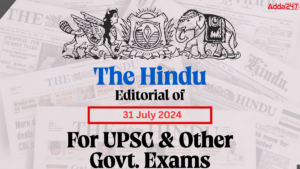Editorial:1 Union budget 2024-25, no sign of learning
Finance Minister Nirmala Sitharaman unveiled the Union Budget for the eighth time in a row under intense political pressure and with enormous expectation. With the passage of this budget plan, the coalition government led by the Bharatiya Janata Party (BJP), which was elected to a third term on the basis of a somewhat moderate mandate, set down its core objectives. The stage had been set by the previous Economic Survey 2023–24, which showed a government preference for relax business rules and encourage private sector leadership in advancing economic growth in the direction of “Viksit Bharat 2047”.
Budget Speech Highlights on Employment and Agriculture
Employment Initiatives:
- Focus on increasing employment, particularly for the educated unemployed.
- Employment Subsidies: Direct and indirect subsidies provided to employers. Scheme to provide ₹15,000 in three installments to new employees with a salary up to ₹1 lakh a month. Government contribution of ₹3,000 per month for two years towards provident fund subscriptions for employers.
- Skilling Schemes: Subsidized internships and interest subvention for educational loans. It Aim to enhance workers’ skills at state expense to make them more employable.
- Assumption: Unemployment is seen as a skill set mismatch rather than a result of inadequate growth.
- Tax Concessions: Direct tax concessions for foreign firms. Indirect tax adjustments to favor domestic manufacturing.
- Private Capital Incentives: The approach involves transferring incentives to private capital to hire the unemployed in “productive” jobs.
Agriculture Initiatives:
- Mismatch in Addressing Agricultural Issues: Peasants demand procurement at a legally guaranteed minimum support price. Budget focuses on a long-term program to raise productivity and production.
- Farmer Sentiment: Farmers, who have been protesting for years, are unlikely to be impressed by the proposed measures.
NDA’s Disappointment with Financial Assistance
- Lack of Significant Financial Support: The National Democratic Alliance (NDA) in India disappointed by the Centre’s lack of financial backing for welfare schemes, especially in politically-sensitive areas.
- JD(U) in Bihar: Promised a combination of transport, power, education, sports, and religious tourism infrastructure as a quid pro quo for political support. Denied significant financial support from the Centre.
- TDP in Andhra Pradesh:
- Offered support to build its new capital at Amravati.
- Promises not backed by significant financial support from the Centre.
- Most spending financed with borrowing, particularly from multilateral development banks (MDBs), facilitated by the Centre.
Ignored Welfare Schemes:
-
- Welfare schemes, heavily emphasized in the election run-up, largely ignored in the 2024-25 Budget.
- National Social Assistance Programme: Allocated the same amount in the 2024-25 Budget as in the revised estimates for 2023-24.
- National Rural Employment Guarantee Programme: Allocated the same amount in the 2024-25 Budget as in the revised estimates for 2023-24.
Put Capital Expenditure and Fiscal Consolidation First
- The Indian Budget focuses on fiscal consolidation and increasing capital expenditure, particularly on infrastructure.
- The fiscal deficit is expected to decrease from 4.9% of GDP in 2023-24 to 4.5% this year, with a promise to continue this path.
- Capital expenditure rose from ₹7,40,025 crore in 2022-23 to ₹9,48,506 crore in 2023-24, and is budgeted to rise further to ₹11,11,111 crore in 2024-25.
- However, tax revenues are not expected to be buoyant, and the budget is expected to increase dividends and surpluses from the Reserve Bank of India and leading public financial institutions. These funds are not available for welfare spending or support for allies.
Conclusion:
While the Union Budget 2024 has impressive goals for infrastructure development and budgetary simplification, it seems to fall short in tackling important economic problems and bolstering social programs. Concerns concerning the viability of this method are raised by the fact that meeting budgetary objectives requires the Reserve Bank of India and public financial institutions to provide ever-increasing dividends and surpluses.



 Why India-Pakistan Partition Needed?
Why India-Pakistan Partition Needed?
 Today The Hindu Editorial of 1 August 20...
Today The Hindu Editorial of 1 August 20...
 The Hindu Editorial Today 31 July 2024, ...
The Hindu Editorial Today 31 July 2024, ...







